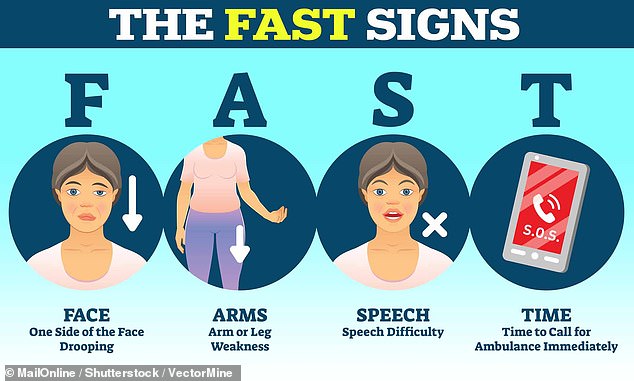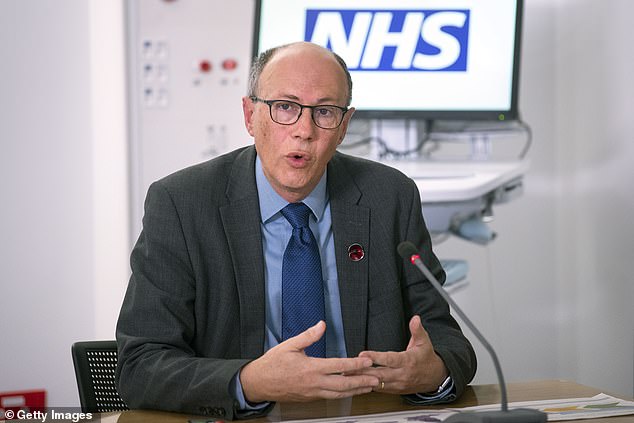Urgent warning about life-threatening signs of stroke that are easily overlooked





Stroke patients die or suffer lifelong disabilities because people typically wait an hour and a half before calling 999, the NHS has warned.
Health bosses say tens of thousands more victims could be saved or make a fuller recovery if the public called an ambulance at the first sign of symptoms.
NHS England is today launching the first major update to its ‘Act FAST’ stroke awareness campaign since 2009.
It encourages people to act immediately if someone experiences any of three common symptoms, including difficulty smiling, difficulty raising an arm or slurring words.
Professor Sir Stephen Powis, national medical director of NHS England, said taking swift action ‘could help save and protect many more lives’.
But the plea comes against a backdrop of slow ambulance response times, with crews routinely failing to arrive within the 18-minute target.
The latest NHS figures show that the average response time for ambulances dealing with emergency calls, such as heart attacks and strokes, was 36 minutes and 2 seconds in September.
Around 100,000 people in Britain every year suffer a stroke, which occurs when the blood supply to part of the brain is cut off.

Symptoms of a stroke are commonly remembered by this four-letter acronym, FAST. Stroke patients may often have their faces droop to one side, have difficulty lifting both arms and may have slurred speech, while time is of the essence as immediate treatment of a transient ischemic attack (TIA) or mild stroke can significantly reduce the risk of stroke. a much deadlier major stroke

Other – just as common – signs of an impending stroke often fall under the radar. These include sudden numbness on one side of the body, sudden dizziness and difficulty swallowing

In September, Queen guitarist Sir Brian May revealed he had suffered a stroke that left him without the use of his left arm
Without prompt treatment, a stroke can lead to death or long-term disabilities such as paralysis, memory loss and communication problems.
The NHS says rapid diagnosis and treatment are ‘vital’ as stroke victims can lose around 2 million brain cells per minute, with delays contributing to greater damage and hampering recovery.
According to a new analysis of NHS data by the Sentinel Stroke National Audit Program, the average time between the first symptom of a stroke and a call to 999 in 2023/2024 was 88 minutes.
The researchers, based at King’s College London, examined the medical notes of 41,327 stroke patients that recorded such figures.
Meanwhile, a new NHS poll found that 57 percent of adults in England believe you should have two to three symptoms of a stroke before calling 999, despite only one symptom being a sign of a medical emergency.
Nearly two-thirds (64 percent) of the 2,001 people surveyed said their first action would not be to call 999 if they noticed someone suddenly struggling to smile.
Sir Stephen said: ‘These figures highlight very clearly that we need to do more to help people recognize the symptoms of stroke in themselves and others and take action to call 999 as soon as possible.
‘The symptoms of a stroke may be less obvious or dramatic than you might expect, but even if they don’t seem that way, any sign of a stroke is always an emergency and it is crucial that you call 999 immediately.

Professor Sir Stephen Powis (pictured), national medical director of NHS England, said taking swift action ‘could help save and protect many more lives’
‘This campaign is so important – greater awareness of the need to act quickly and call 999 could help save and protect many more lives, because we know that earlier recognition of symptoms and immediate action to call 999 is a faster access to specialist treatment and the best chance of reducing the long-term effects of stroke.”
NHS England said that thanks to advances in care, more people are now surviving a stroke than ever before, but strokes remain the fourth leading cause of death in Britain, with 38,000 fatalities every year.
Juliet Bouverie, chief executive of the Stroke Association, said: ‘Over 88,000 people survive a stroke in Britain every year, but surviving a stroke is just the start of a long and traumatic battle to find the way back to life. find.
‘Mothers, fathers, grandparents, young people and even children can survive a stroke, and the impact of a stroke on them and their loved ones can be catastrophic.
‘This new NHS campaign is so important to raise awareness that stroke is always a medical emergency.
‘If you notice any of the three common symptoms of a stroke in someone, the first thing you should do is call 999.
‘The sooner many stroke treatments are given, the better.
‘As we say, ‘time is brain’, so it’s important to recognize the signs of a stroke and act immediately.
‘Acting FAST is essential for surviving a stroke and helping improve the journey to recovery.’




